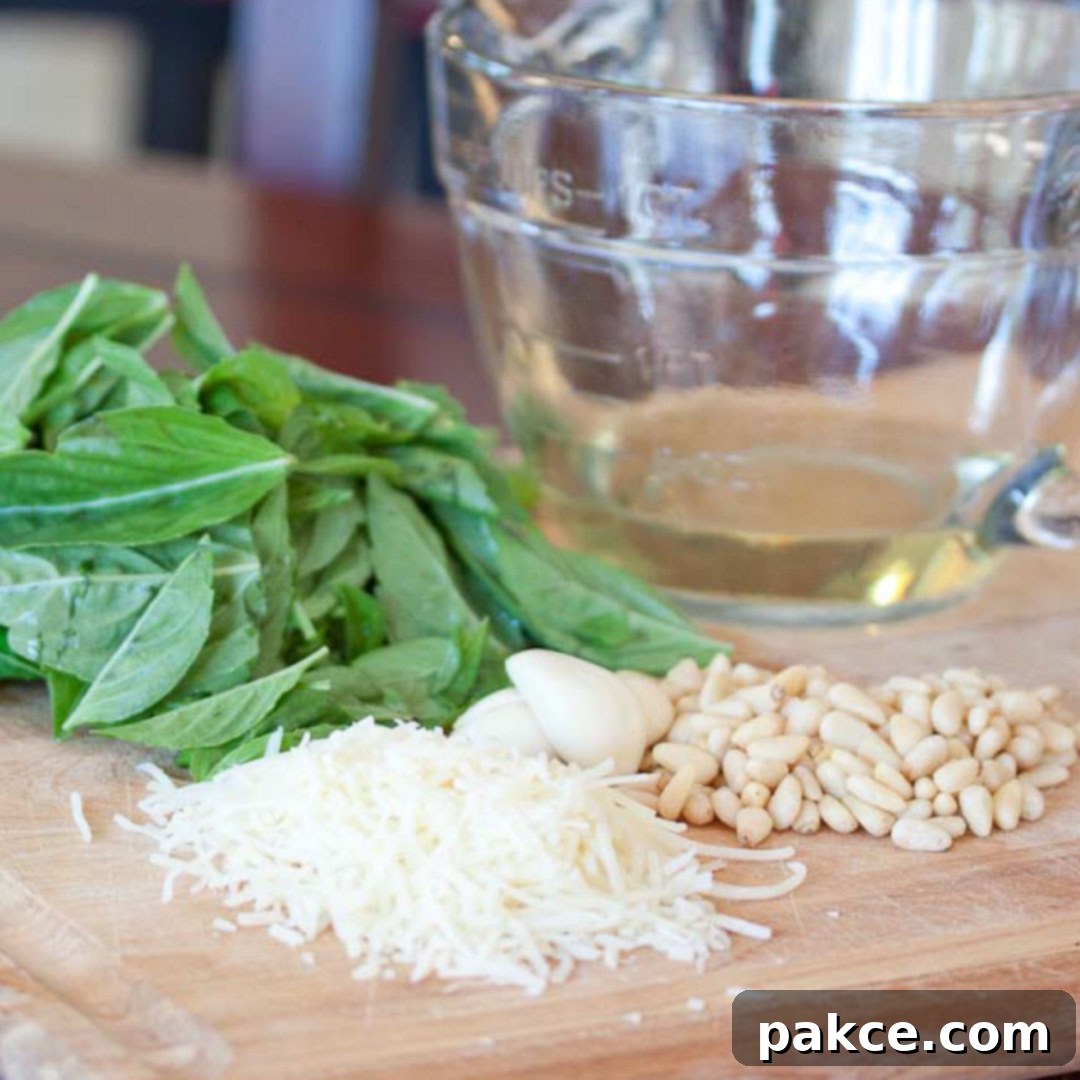The Ultimate Guide to Homemade Pesto: Fresh, Flavorful, and Incredibly Easy
There’s nothing quite like the vibrant, aromatic taste of fresh homemade pesto. This incredibly versatile sauce is a kitchen staple, perfect for elevating simple pasta dishes, adding a burst of flavor to grilled chicken, or serving as a delightful spread for sandwiches and toast. Forget expensive store-bought versions; making pesto from scratch is not only quick and easy but also surprisingly cost-effective, especially when you have a thriving basil plant on hand.
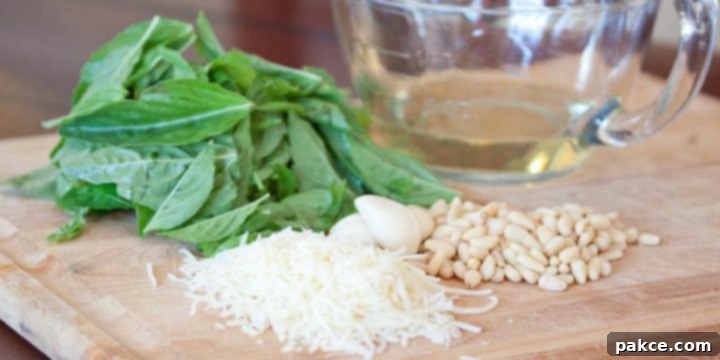
One of the secrets to delicious pesto is using fresh basil, and it’s surprisingly easy to ensure a continuous supply. Most grocery stores offer pots of living basil for under five dollars. With a sunny window and consistent watering, these plants can thrive for months, providing you with fragrant leaves whenever inspiration strikes. This simple gardening trick makes homemade pesto an incredibly affordable luxury. While you might need to replace a plant once a year, particularly during the shorter days of mid-winter, this minor expense is still far less than continuously buying fresh-cut basil bundles.
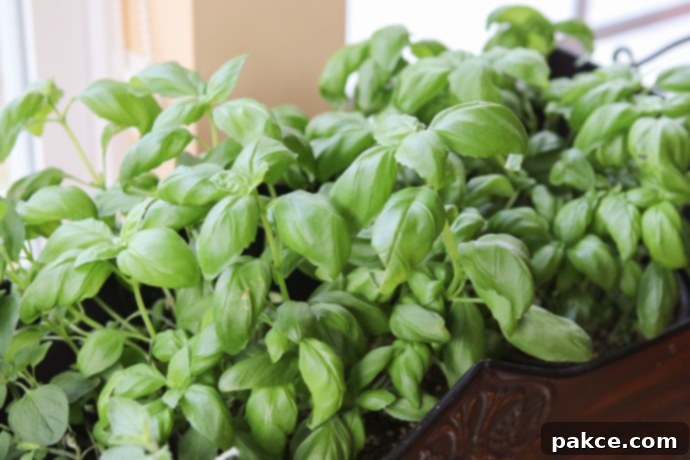
Why Homemade Pesto Reigns Supreme
The difference between homemade pesto and its store-bought counterparts is monumental. Freshly made pesto boasts a brighter, more complex flavor profile, a vibrant green hue, and a superior texture that simply can’t be replicated by mass-produced varieties. When you make pesto at home, you control the quality of the ingredients, ensuring the freshest basil, the finest olive oil, and the perfect balance of garlic and cheese. This control also allows for dietary adjustments, like reducing sodium or experimenting with nut-free alternatives. Plus, the sheer satisfaction of creating such a gourmet sauce in minutes is a reward in itself.
The Heart of Pesto: Fresh Basil
Keeping fresh basil readily available is the cornerstone of easy homemade pesto. Basil provides the distinctive, aromatic foundation that gives pesto its unique character. Using leaves that you’ve just snipped from the stem guarantees maximum flavor and freshness, which translates directly into an incredibly vibrant and potent pesto. Our recipe calls for 2 cups of basil, an amount you can often harvest from a single healthy potted plant purchased from your local grocery store’s produce section, or even more easily from a home-grown plant.
Tips for Growing and Maintaining Your Basil Plant
- Sunny Spot: Basil thrives in sunlight. Place your potted plant in a south-facing window or a location that receives at least 6 hours of direct sunlight daily.
- Consistent Watering: Keep the soil consistently moist but not waterlogged. Water thoroughly when the top inch of soil feels dry.
- Pinch Back Regularly: To encourage bushier growth and prevent the plant from flowering (which can make the leaves bitter), regularly pinch off the top sets of leaves. This is essentially your harvest!
- Rotate Your Plant: Turn your pot every few days to ensure all sides get adequate sunlight.
- Consider a Larger Pot: If your store-bought basil comes in a small pot, transplanting it to a slightly larger one can give its roots more room to grow and extend its life.
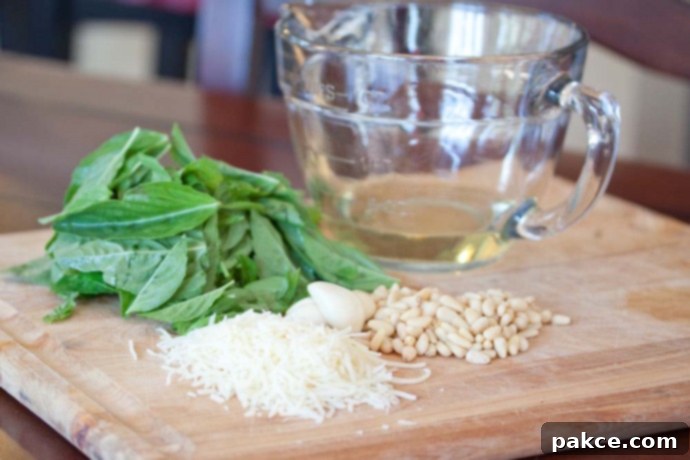
The Essential Ingredients for Authentic Pesto (and their roles)
While basil is the star, the other components play crucial supporting roles in creating a perfectly balanced pesto. Each ingredient contributes to the texture, aroma, and overall flavor:
- Fresh Basil Leaves: As discussed, these provide the signature vibrant green color and intense, sweet-peppery aroma.
- Pine Nuts: Traditionally used, pine nuts add a subtle, buttery richness and help achieve the desired creamy consistency. For enhanced flavor, lightly toast them in a dry skillet for a few minutes until golden and fragrant before adding them to the food processor. If pine nuts are unavailable or too expensive, walnuts or almonds make excellent substitutes.
- Parmesan Cheese: Freshly grated Parmesan (Parmigiano-Reggiano) offers a salty, umami depth that is irreplaceable. Avoid pre-grated cheeses, as they often contain anti-caking agents that can affect the pesto’s texture. Pecorino Romano, a sharper sheep’s milk cheese, can also be used for a more robust flavor.
- Garlic Cloves: Fresh garlic provides a pungent, aromatic kick. The amount can be adjusted to your preference – some prefer a milder garlic note, while others enjoy a more intense flavor.
- Extra Virgin Olive Oil: This is more than just a binder; it’s a key flavor component. Use a good quality, mild extra virgin olive oil for the best results, as its flavor will shine through in the finished pesto.
- Salt (and Pepper, optional): A pinch of salt enhances all the other flavors. Freshly ground black pepper is optional but can add a subtle complexity.
When you’re serving pesto with pasta, the entire sauce can be prepared in the time it takes for the pasta water to boil and the pasta to cook. This truly makes homemade pesto a quick and delightful stovetop meal, perfect for busy weeknights.
Recipe
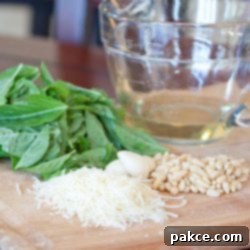
Homemade Pesto
Add to Shopping ListGo to Shopping List
Ingredients
- 2 cups fresh basil leaves, washed, stems removed, and packed into cup
- ¼ cup Parmesan Cheese, freshly grated for best flavor
- ½ cup extra virgin olive oil, good quality
- 3 tablespoon pine nuts, lightly toasted for enhanced flavor (optional)
- 3 large garlic cloves, minced (adjust to taste)
- ½ teaspoon salt, or to taste
Instructions
-
In a food processor, place about one-third of the basil leaves. Pulse until they are finely chopped. You might need to scrape down the sides of the bowl to ensure even processing.
-
Add about one-third of the pine nuts and one-third of the minced garlic to the chopped basil. Process again until well combined and finely chopped.
-
Add about one-third of the Parmesan cheese and, with the food processor running on low, slowly drizzle in about one-third of the olive oil through the feed tube. Continue blending until a thick, smooth paste begins to form.
-
Stop the food processor and use a spatula to scrape down the contents from the sides of the container towards the bottom. This ensures all ingredients are incorporated evenly. Continue processing until the pesto reaches your desired consistency – smooth or slightly chunky.
-
Repeat this layering process with the remaining basil, nuts, garlic, cheese, and olive oil, adding them in approximately one-third increments, scraping down the sides as needed, until all ingredients are used and a beautiful, emulsified pesto is formed. Season with salt to taste.
Notes
Nutrition data is for the entire recipe as prepared.
Nutrition per serving
Share
Pin
Beyond Pasta: Versatile Ways to Enjoy Pesto
While pesto and pasta are a classic match, this vibrant sauce offers so much more culinary potential. Don’t limit yourself to just one application! Here are myriad ways to incorporate homemade pesto into your meals:
- Pizza Topping: Spread a thin layer on pizza dough instead of tomato sauce for a fresh, herbaceous base. Top with your favorite ingredients.
- Sandwich and Wrap Spread: Ditch the mayonnaise! Pesto adds an incredible depth of flavor to deli sandwiches, wraps, and even grilled cheese.
- Roasted Vegetables: Toss roasted potatoes, carrots, zucchini, or broccoli with pesto for a flavorful side dish.
- Marinade: Use it as a quick marinade for chicken, fish, shrimp, or pork before grilling, baking, or pan-searing.
- Eggs: Swirl a spoonful into scrambled eggs, an omelet, or a frittata for an instant flavor boost.
- Soup Topping: A dollop of pesto on top of a minestrone, vegetable, or tomato soup adds freshness and richness.
- Dips & Spreads: Mix with Greek yogurt, sour cream, or cream cheese for a flavorful dip for crackers, veggies, or a spread for bagels.
- Crostini & Bruschetta: Spread on toasted bread slices and top with fresh tomatoes, mozzarella, or other antipasto items.
- Salad Dressing Base: Whisk with a little extra olive oil, vinegar, or lemon juice for a quick and zesty salad dressing.
- Compound Butter: Blend into softened butter to create a flavored butter perfect for spreading on bread or melting over steaks and corn on the cob.
Exploring Pesto Variations: Get Creative!
The beauty of homemade pesto lies in its adaptability. Once you master the classic recipe, feel free to experiment with different ingredients to create your unique spin:
- Nut Swaps: Replace pine nuts with walnuts (for a earthier, slightly bitter note), almonds (sweeter, softer texture), pistachios (nutty, vibrant green), or even sunflower seeds (nut-free option).
- Cheese Alternatives: While Parmesan is traditional, try Pecorino Romano for a sharper, saltier kick, or a blend of both. For a dairy-free version, nutritional yeast can mimic a cheesy flavor.
- Herb & Green Blends: Experiment with mixing basil with other greens like spinach, arugula (for a peppery bite), kale, or even cilantro for a Mexican-inspired pesto. Sun-dried tomatoes can also be added for a rich, umami flavor.
- Citrus Zest: A little lemon zest or a squeeze of fresh lemon juice can brighten the flavors and add a refreshing zing.
- Spice It Up: A pinch of red pepper flakes can add a subtle heat to your pesto, particularly if you’re serving it with spicier dishes.
Conclusion: Embrace the Pesto-Making Journey
Making homemade pesto is a truly rewarding culinary experience. It’s a testament to how a few simple, high-quality ingredients can transform into an extraordinary sauce that elevates countless dishes. From the satisfying process of blending fresh basil to the myriad ways you can incorporate it into your cooking, homemade pesto offers unparalleled flavor, freshness, and versatility. So, grab your food processor, a handful of fresh basil, and embark on your own pesto-making journey. Your taste buds will thank you!
More delicious recipes with vegetarian options:
- Lemon Orzo with Asparagus, Parmesan, and Peas
- Crustless Cottage Cheese Quiche
- Carrot Sweet Potato Soup with Ginger – Perfect for Any Season
- Roasted Garlic Broccoli
